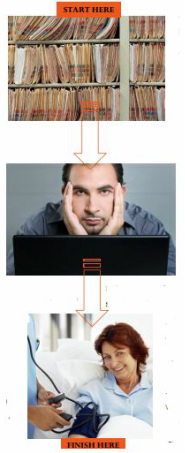
We admit it...for some providers, it may take a little extra time to see a patient using an EHR.
Just the other day, one of our physicians quoted a random stat about how much more time it was taking him now to do what he used to do when he was on paper.
That may be true, but EHR is still a work in progress, and what should
the ultimate goal be?
Improved patient care, right?
The PATIENT is who matters.
Patient care is why the federal government is investing up to $29 billion in the Meaningful Use incentive program, but EHR users, understandably so, want to know if it’s working.
One recent study released in the Journal of General Internal Medicine (J Gen Intern Med, Pub. Online Oct. 3, 20011 DOI: 10.1007/s11606-012-2237-8) set out to gather data on ambulatory quality in community based settings using EHR.
The study, which included 466 physicians; 204 using EHR, 262 using paper) and 74,618 unique patients, compared nine measures within the group. The results showed significantly higher quality of care for four of the
measures:
1. Hemoglobin A1c testing in diabetes,
2. Breast cancer screening,
3. Chlamydia screening, and
4. Colorectal cancer screening
When all nine measures were combined into a composite, EHR use was associated with higher quality of care. The authors do list several limitations, such as the inclusion of self-reported adoption of EHR in its predictor variable, as well as the small number of pediatric measures (although consistent with the call for development of more
pediatric measures).
But even with such limitations, this study is significant in that EHR now can be qualified. In this “multi-payer community with concerted efforts to support EHR implementation,” EHR was found to indeed be meaningful. If Quillen, as an organization, can work together to improve the current system, the patient is the one who will
reap the benefits.
Just the other day, one of our physicians quoted a random stat about how much more time it was taking him now to do what he used to do when he was on paper.
That may be true, but EHR is still a work in progress, and what should
the ultimate goal be?
Improved patient care, right?
The PATIENT is who matters.
Patient care is why the federal government is investing up to $29 billion in the Meaningful Use incentive program, but EHR users, understandably so, want to know if it’s working.
One recent study released in the Journal of General Internal Medicine (J Gen Intern Med, Pub. Online Oct. 3, 20011 DOI: 10.1007/s11606-012-2237-8) set out to gather data on ambulatory quality in community based settings using EHR.
The study, which included 466 physicians; 204 using EHR, 262 using paper) and 74,618 unique patients, compared nine measures within the group. The results showed significantly higher quality of care for four of the
measures:
1. Hemoglobin A1c testing in diabetes,
2. Breast cancer screening,
3. Chlamydia screening, and
4. Colorectal cancer screening
When all nine measures were combined into a composite, EHR use was associated with higher quality of care. The authors do list several limitations, such as the inclusion of self-reported adoption of EHR in its predictor variable, as well as the small number of pediatric measures (although consistent with the call for development of more
pediatric measures).
But even with such limitations, this study is significant in that EHR now can be qualified. In this “multi-payer community with concerted efforts to support EHR implementation,” EHR was found to indeed be meaningful. If Quillen, as an organization, can work together to improve the current system, the patient is the one who will
reap the benefits.
 RSS Feed
RSS Feed